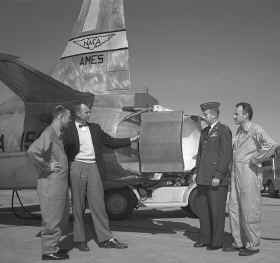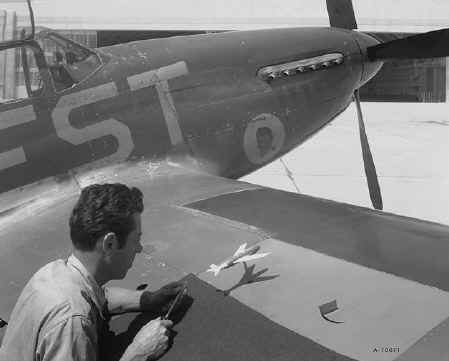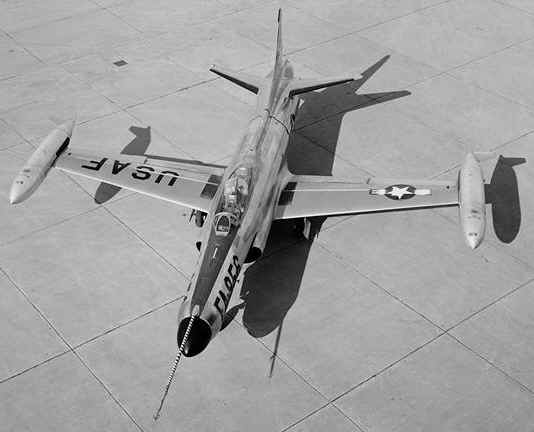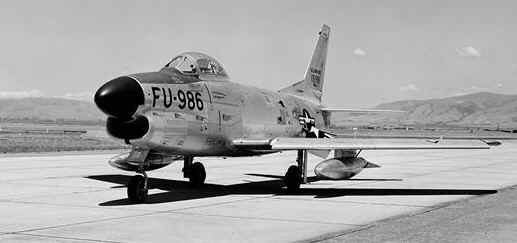by Martin Waligorski
The Dawn of the Jet Age
Early jet aircraft development – a period between 1945 and mid-1950s – is an interestig time in aviation history. In an immediate post-war decade, flight technology leaped from being dominated by propeller-driven aircraft to an era of mighty machines capable of flying faster than sound.
This development, of course, had to be backed by massive research and testing. Hundreds of airframes were engaged in tests in the U.S. alone.
From the modeller’s point of view, test aircraft make attractive subjects. Often colorful color schemes coupled with unorthodox changes in configuration offer a possibility to go beyond the usual.
This series of photographs shows a number of early American jet aircraft used for testing at NACA, starting from the P-80 and ending with F-100. Enjoy.
Early American Jet Aircraft in Test
United States got off to a late start in the new field of jet propulsion. Pre-emptied by both the Germans and the British, the USAF only managed to put it’s first combat-ready jet fighter to service after the end of hostilities.
One of Lockheed YP-80A Shooting Star pre-production machines is seen here in October 1945. The aircraft is configured for studies of the aileron buzz problem and boundary-layer characteristics. Photo: NASA
The Lockheed P-80 Shooting Star distinguished itself by other ”firsts”, too. It was the first American production combat aircraft to exceed 500 mph in level flight. It was the first American jet-powered aircraft to score a victory in air-to-air combat. For a brief time, it also held the world’s air speed record.
This early production Lockheed P-80A was employed for advanced flight tests at Ames Research Center in the summer of 1946. Photo: NASA
During the first post-war years, NACA conducted an extensive research programme on high-speed flight. This interesting photo shows a supersonic model being mounted on the starboard wing ofa North American P-51B Mustang for in-flight testing. Due to their aerodynamic qualities, Mustangs were widely used as test beads before suitable jet aircraft became available. Note the presence of nose art on this example. Photo: NASA
Yet another P-80A is seen here showing vortex generator installation. Investigation of the effect of vortex generators on the aileron buzz and buffeting was conducted by NACA in 1951. Photo: NASA
Pre-production Republic YP-84A-5. YP-84 was the originator of the F-84 Thunderjet, the USAF’s first post-war fighter. It made its initial flight on February 26, 1946, this photo being taken in 1948, one year after the type’s entry into front-line service. Photo: NASA
The North American F-86 Sabre was the USAF’s first swept-wing jet fighter. The first production model flew on May 20, 1948, and on September 15 an F-86A set a new world speed record of 670.9 mph.This F-86A featured extra airspeed probes for tests conducted in the spring of 1950. Photo: NASA
Vought rolled out the F6U Pirate in 1946. The first Navy jet experience was a total dissapointment. In an attempt to increase performance of the aircraft, Vought and the Navy added a newly-developed afterburner to the exhaust pipe of the J34 engine. Even with this improvement, the Pirate proved inadequate for sea duty. Only 30 F6U-1s were built. Photo: NASA
The YF-93A was a development of the F-86 Sabre with a solid nose and flush NACA intakes, intended as long-range penetration fighter. It actually had an entirely new fuselage with accordingly enlarged fuel tanks. The F-93 almost made it into production, but fell victim of budget cuts. Only two aircraft were built. Both of them are shown here with different intake configurations during flight tests in 1951.
Photo: NASA
The Lockheed F-94 Starfire series all-weather interceptors were developed from the F-80 Shooting Star. The prototype F-94 first flew on July 1, 1949. The Starfire was subsequently produced in the -A, -B, and -C series. The F-94C was a fundamental improvement over the earlier versions, featuring a more powerful engine, a redesigned wing and a swept-back horizontal stabiliser Starfires were employed in the air defence of the U.S. during the 1950s.
This test F-94C features an in-flight thrust reverser, which was hoped to increase combat manoeuvrability. The inset photo to the right shows the installation.
reverser, which was hoped to increase combat manoeuvrability. The inset photo to the right shows the installation.
Photo: NASA
FU-986, the North American F-86D was photographed at NACA in June 1953, but appears to be in standard configuration, at least externally.
The F-86D version of the famous Sabre was developed as an all-weather interceptor. It was the first USAF aircraft to have all-rocket armament, and the first all-weather interceptor to carry only one crew member. It also set two world’s speed records – 698.505 mph on November 19, 1952 and 715.697 mph on July 16, 1953. Photo: NASA
Another ordinarily-looking F-86D Sabre was used to flight-test new weapon guidance systems during 1956. Photo: NASA
The aggressively-looking Republic F-84F Thunderstreak was designed as a successor to the straight-wing F-84 Thunderjet. Although 85% of the airframe was entirely new, the same type number was kept for political reasons (it was meant to be the F-96 at first). The prototype made its maiden flight June 3, 1950, but front-line deliveries began no sooner than in in 1954. The machine is one of the first production F-84F-5-RE during the stability and control characteristics tests in December, 1953. Photo: NASA
Following the swept-wing trend, Grumman developed it’s F9F-5 Panther into F9F-6 Cougar, by incorporating a more powerful engine and new wings on the Panther’s fuselage and tail unit. The F9F-6 first flew on September 20, 1951.
The F9F-8 depicted here was the last fighter version of the Cougar to see production. This standard operational machine was delegated to bombing sight tests during 1955. Photo: NASA
Lockheed TV-1 was a Navy trainer version of the P-80. This specimen served as a test-bed for a remote air-launched missile control system. Seen here at Ames Research Center on December 15, 1955. Photo: NASA
With the advent of true supersonic fighters like the North American F-100 Super Sabre the jet technology reached maturity. In May 1953 the first prototype YF-100 bettered the speed of sound on its maiden flight.
This photo shows an F-100A on take-off. Photo: NASA
The Navy’s first supersonic mount was Douglas F4D Skyray, later redesignated F-6. The F4D-1 was the initial production version of the Skyray. The first production F4D-1 took off on its maiden flight on June 5, 1954. Problems with high-speed turbulence and engine stalls at altitude delayed the service introduction until early 1956.
This F4D-1 (Bu. No. 134759), the nineteenth production machine, was photographed during the above test period in April 1956, with the test pilot Don R. Heinle in front of it. During the tests it was found necessary to modify the geometry of the air intakes and to add an airflow baffle plate ahead of each air intake. The aircraft is shown in modified configuration. Photo: NASA
This article was 2000.originally published in IPMS Stockholm Magazine in January 2000.
















